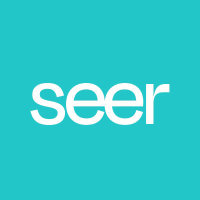
Seer Inc
NASDAQ:SEER


| US |

|
Johnson & Johnson
NYSE:JNJ
|
Pharmaceuticals
|
| US |

|
Berkshire Hathaway Inc
NYSE:BRK.A
|
Financial Services
|
| US |

|
Bank of America Corp
NYSE:BAC
|
Banking
|
| US |

|
Mastercard Inc
NYSE:MA
|
Technology
|
| US |

|
UnitedHealth Group Inc
NYSE:UNH
|
Health Care
|
| US |

|
Exxon Mobil Corp
NYSE:XOM
|
Energy
|
| US |

|
Pfizer Inc
NYSE:PFE
|
Pharmaceuticals
|
| US |

|
Palantir Technologies Inc
NYSE:PLTR
|
Technology
|
| US |

|
Nike Inc
NYSE:NKE
|
Textiles, Apparel & Luxury Goods
|
| US |

|
Visa Inc
NYSE:V
|
Technology
|
| CN |

|
Alibaba Group Holding Ltd
NYSE:BABA
|
Retail
|
| US |

|
3M Co
NYSE:MMM
|
Industrial Conglomerates
|
| US |

|
JPMorgan Chase & Co
NYSE:JPM
|
Banking
|
| US |

|
Coca-Cola Co
NYSE:KO
|
Beverages
|
| US |

|
Walmart Inc
NYSE:WMT
|
Retail
|
| US |

|
Verizon Communications Inc
NYSE:VZ
|
Telecommunication
|
Utilize notes to systematically review your investment decisions. By reflecting on past outcomes, you can discern effective strategies and identify those that underperformed. This continuous feedback loop enables you to adapt and refine your approach, optimizing for future success.
Each note serves as a learning point, offering insights into your decision-making processes. Over time, you'll accumulate a personalized database of knowledge, enhancing your ability to make informed decisions quickly and effectively.
With a comprehensive record of your investment history at your fingertips, you can compare current opportunities against past experiences. This not only bolsters your confidence but also ensures that each decision is grounded in a well-documented rationale.
Do you really want to delete this note?
This action cannot be undone.

| 52 Week Range |
1.54
2.55
|
| Price Target |
|
We'll email you a reminder when the closing price reaches USD.
Choose the stock you wish to monitor with a price alert.

|
Johnson & Johnson
NYSE:JNJ
|
US |

|
Berkshire Hathaway Inc
NYSE:BRK.A
|
US |

|
Bank of America Corp
NYSE:BAC
|
US |

|
Mastercard Inc
NYSE:MA
|
US |

|
UnitedHealth Group Inc
NYSE:UNH
|
US |

|
Exxon Mobil Corp
NYSE:XOM
|
US |

|
Pfizer Inc
NYSE:PFE
|
US |

|
Palantir Technologies Inc
NYSE:PLTR
|
US |

|
Nike Inc
NYSE:NKE
|
US |

|
Visa Inc
NYSE:V
|
US |

|
Alibaba Group Holding Ltd
NYSE:BABA
|
CN |

|
3M Co
NYSE:MMM
|
US |

|
JPMorgan Chase & Co
NYSE:JPM
|
US |

|
Coca-Cola Co
NYSE:KO
|
US |

|
Walmart Inc
NYSE:WMT
|
US |

|
Verizon Communications Inc
NYSE:VZ
|
US |
This alert will be permanently deleted.
 Seer Inc
Seer Inc
Seer Inc
Investor Relations
Seer, Inc. (California) engages in the development of proprietary engineered nanoparticles to provide access across the proteome. The company is headquartered in Redwood City, California and currently employs 118 full-time employees. The company went IPO on 2020-12-04. The firm enables scientific outcomes by commercializing products for researchers to unlock biological information. Its initial product, the Proteograph Product Suite (Proteograph), uses its engineered nanoparticle (NP) technology to provide access across the proteome. Its Proteograph Product Suite is comprised of consumables, an automation instrument and software. Its Proteograph provides a workflow, which enables proteomic profiling and the analysis of samples needed to characterize the nature of the proteome. The Company’s Proteograph consumables consist of its NP panel and other consumables necessary to assay samples on its SP100 automation instrument. Its SP100 automation instrument is custom-configured liquid handling workstation. The firm's Proteograph Instrument Control Software (PICS) for the SP100 instrument is fixed and designed to its specified workflow.

Seer, Inc. (California) engages in the development of proprietary engineered nanoparticles to provide access across the proteome. The company is headquartered in Redwood City, California and currently employs 118 full-time employees. The company went IPO on 2020-12-04. The firm enables scientific outcomes by commercializing products for researchers to unlock biological information. Its initial product, the Proteograph Product Suite (Proteograph), uses its engineered nanoparticle (NP) technology to provide access across the proteome. Its Proteograph Product Suite is comprised of consumables, an automation instrument and software. Its Proteograph provides a workflow, which enables proteomic profiling and the analysis of samples needed to characterize the nature of the proteome. The Company’s Proteograph consumables consist of its NP panel and other consumables necessary to assay samples on its SP100 automation instrument. Its SP100 automation instrument is custom-configured liquid handling workstation. The firm's Proteograph Instrument Control Software (PICS) for the SP100 instrument is fixed and designed to its specified workflow.





























 You don't have any saved screeners yet
You don't have any saved screeners yet
